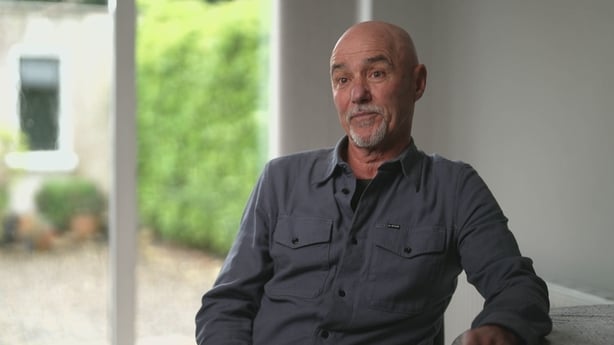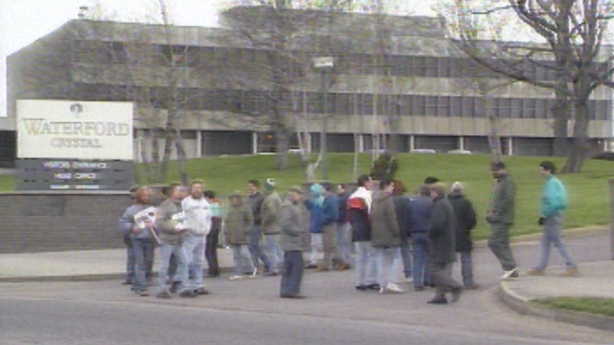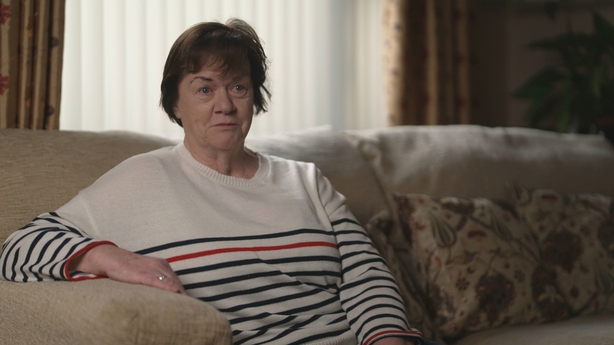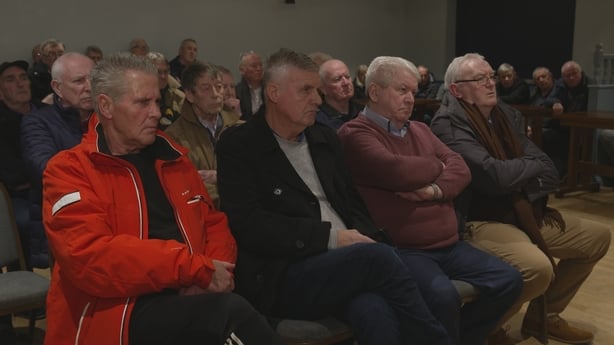They are part of a larger group, involved as they see it, in a battle that is decades-old.
On an evening in late February, they arrived in dribs and drabs to a meeting room at Roanmore GAA Sports and Social Club, on the outskirts of Waterford City.
Most are of pension age and most are men. Roughly 80 of them assembled.
They are some of hundreds of working class people from around the South East who used to work for a company that was globally-known, Waterford Crystal.
On the other side in this battle is their now-defunct former employer, a leading pension fund management company, and the Department of Social Protection.
The former workers allege that Waterford Crystal Limited failed to properly inform them of their pension options when they were taking redundancy, as a result leaving them without an occupational pension and reliant on the state pension.
One of the organisers, 75-year-old Walter Croke, addressed the room, updating them on recent developments in their campaign for redress. He worked at Waterford Crystal for 27 years. His story is, more or less, their story.
A former master glassblower, Mr Croke first joined what was an icon of Waterford’s manufacturing sector in 1965, shortly before his 16th birthday.
“That was the top job you could get in Waterford,” he told Prime Time.

But by the late 1980s, Waterford Crystal was loss-making and management began to cut bonus payments for some workers. It prompted resistance and a bitter and unsuccessful 14-week strike in 1990.
After the strike, the still-struggling company sought voluntary redundancies. The package on offer was generous, though not as generous as a previous redundancy scheme in 1987, when at least 750 workers left the company.
However, in relation to their pensions, hundreds of workers claim that the company misinformed them by offering only one pension option – the return of their pension contributions. By accepting this, workers were signing away their pension rights.
When they reached retirement age they would have no occupational pension from their time in Waterford Crystal.
In Walter Croke’s case the refund of his pension contributions amounted to the Irish punt equivalent of €3,909 in an after-tax once-off payment. The figure was small because workers only began to contribute to their pension in 1989 – until then, the company entirely funded the pension.
While Mr Croke’s entire redundancy package of the equivalent of €43,000 was well beyond the statutory minimum, according to the law he should have been advised of his pension options, including his right to a deferred pension of €14,232 annually at 61.
But, he says, he was not. He claims that he was only given one option. The return of his pension contributions was “the only offer” that he received, he said.
And by accepting the once-off payment of less than €4,000, Walter Croke was not entitled to a deferred annual pension of over €14,000.

Around 400 others who retired in or around 1992 also took a refund of their pension contributions instead of a deferred pension. They also claim they were not advised of their pension options.
“It was just ‘sign there’ and there was your money and that was it – there were no options,” said Tom Murphy, who worked in the factory as a cutter for 20 years.
That may have been bad financially for them, but it was good financially for the struggling company and its defined benefit pension scheme. The more workers who signed away their pension rights, the better for the company’s future pension liabilities.
What workers like Walter Croke did not know was that in April 1992 – six months before he accepted redundancy – his union, the ATGWU (now Unite), had written a letter to Irish Pensions Trust, which managed Waterford Crystal’s pension fund.
The letter expressed concern, saying: “It would appear that the company are using a refund of pension contributions as part of a redundancy package… We believe the company and IPT as trustees are not fullfilling [sic] their obligations in informing the members of the options available to them on leaving the scheme.”
Irish Pensions Trust wrote back a week later to say that it had discussed the matter with senior Waterford Crystal management. “It was agreed that” workers taking redundancy “should be given details of the various options available to them from the Pension Scheme and this is currently being implemented,” the IPT letter said.
The following week, a senior manager from Irish Pensions Trust wrote to management at Waterford Crystal, emphasising the importance of notifying departing workers of their pension options.
The Pensions Trust manager also included a form that outlined three pension options for workers. Option A was a deferred pension, Option B to transfer the value of the pension (to another pension fund) and Option C was a refund of employee pension contributions. The IPT manager specified that “the Form should be signed by the member, the Company and the Trustees and signed copies will be held by the three parties.”
The message from Irish Pensions Trust to Waterford Crystal was clear – departing workers should have been informed of their pension rights.
The backdrop to the 1992 redundancy scheme was repeated financial losses for Waterford Crystal Limited, threatening the existence of the company.
Anne Hammond’s deceased husband Tosh had taken part in the 1990 strike that lasted from April to July 1990. The strike began on their 11th wedding anniversary. Mortgage payments “went out the window”, she remembers, “times were very hard.”

But the end of the strike did not mean an end to the hard times, she told Prime Time.
“They were brought back on short time. So, it meant you were in a week and off a week. So you were nearly as badly off because then the bank started putting pressure on, looking for the mortgages that you failed on to be paid.”
Faced with declining pay and conditions and failing health, Tosh Hammond decided to take redundancy.
Like other workers, he claimed that he was not informed of his pension options.
Ms Hammond told Prime Time, “I don’t think he was very switched on either to his proper entitlements.”
The company, she added, “told him that’s what he was entitled to… and we accepted it.”
However, under the law the onus was not on the workers to be aware of their pension entitlements – they should have been told what their options were.
The forms that Irish Pensions Trust sent to Waterford Crystal included a space to give an illustration of the financial value of each option.
Such illustrations had been provided to workers accepting redundancy under the previous scheme in 1987.
Former workers remember that the ATGWU union (now Unite) was heavily involved in clarifying details of the 1987 redundancies, but much less so in 1992, when it actively discouraged workers from leaving.
In effect, they say, the company dealt with workers on an individual basis.
Tosh Hammond ended up signing away his pension rights for a payment of €2,758 as part of a package worth over eleven times that figure.
“He had worked there for 23 years… I would have expected when he was 65 that there would have been a pension, but there wasn’t,” Anne Hammond said.

In 2001, Walter Croke was part of a group of over 300 workers who sued Waterford Crystal and the company’s pensions manager, Irish Pensions Trust (IPT).
He says that if he had been advised of his right to have a deferred pension when he took redundancy, a copy of his signed pensions options form should have been produced before or during the court case.
“All the documentation was to be signed. A copy was to be kept by the pension provider, the employer, Waterford Crystal, and the individual,” Mr Croke said.
“I can understand that that I, as an individual, could have [torn] up my copy of the options and went out there screaming to the whole world, ‘I never got my options, I never got my options,’” he said.
“But the safeguard was there for the company and IPT that they had a copy of my signed options form, and I am still waiting in 2024 to see where that option form is,” he said.
Local Green Party TD Marc Ó Cathasaigh says the fact that paperwork has not surfaced showing that workers knowingly signed away their right to an occupational pension supports the workers’ argument.
“It’s been said to me openly by the workers that if this paperwork was produced to them, that they’d walk away, that they’d accept, ‘well, okay, we’ve signed away in the full knowledge.’ That paperwork has never been produced to them,” Deputy Ó Cathasaigh told Prime Time.

Irish Pensions Trust settled the court case with Waterford Crystal workers in 2009.
Walter Croke received a payment of €22,000.
That figure was significantly less than the €179,121 loss he suffered by signing away his pension rights, according to an actuarial calculation prepared to support his court case.
Irish Pensions Trust consistently denied any liability in the case. In response to a list of questions from Prime Time, it said it considers that the matter has been “resolved in its entirety in 2009.”
It said it has “encouraged individuals who have remaining concerns about the scheme to contact the Pensions Authority and/or the Financial Services and Pensions Ombudsman.”
Neither the Pensions Authority nor the Financial Services and Pensions Ombudsman would comment to Prime Time, though they have stated in correspondence to complainants that their remit does not extend back to cases as old as 1992.
Waterford Crystal closed its operations in early 2009. Workers who were part of its then significantly underfunded pension scheme successfully brought a case to Europe that ultimately forced the State to fund most of their pensions.
Walter Croke and about 400 other workers were not included in that deal because they were deemed to have signed away their pension rights.
Crystal is still made in the city under the Waterford name; a small factory and showrooms are operated by Finnish multinational Fiskars at the House of Waterford in the city centre. Almost 70 of the 130-strong workforce are employed directly in manufacturing, a spokesperson said. That company has no connection with Waterford Crystal Limited and no obligation regarding the occupational pensions of the former Waterford Crystal workers.
The campaign by the former workers rumbles on. Last month, Waterford City and County Council passed a motion requesting that the Minister for Social Protection initiate an independent review into the matter.

The chances of the Government stepping in with a chequebook to help out the former workers appear remote, partly due to fears of triggering claims from other private sector workers who may have been treated similarly.
“There has to be a mechanism whereby the Government can make this happen or the Department of Social Protection. And it has to be something that can be legally stood over and can protect the state from future liability,” said Deputy Ó Cathasaigh.
There appears to be little appetite at the Department of Social Protection to assist the former workers.
In 2017, for example, responding to local Fianna Fáil TD Mary Butler, Minister for Social Protection Regina Doherty stated, “Former workers who left the service of Waterford Crystal in the early 1990s received their full pension entitlements in relation to pre-1991 service under the schemes at that point.”
“I do not intend to commence any investigation in relation to historic settlements agreed between the Waterford Crystal pension scheme trustees and members prior to the windup of the scheme,” then Minister Doherty added.
Those who gathered in Roanmore GAA Sports and Social Centre in late February say they will continue their fight for an occupational pension.
“We were totally excommunicated, just told just go away. So, I’m looking at the Department of [Social] Protection to give me some protection,” said Tom Murphy.
“I’m hoping that the government are going to listen. That’s the only chance we have,” said another former worker, John Lynagh.
One of the few women at the meeting, Anne Hammond, said she would continue to fight the battle that her husband Tosh was involved in until his death in 2004.
Some of the former workers “feel very, very, very robbed,” she said.
“They feel they worked hard and gave all they did. And some of them are older than Tosh, so they would have given more years. And they just feel that they got thrown out on the heap.”
A report from Paul Murphy and Isabel Perceval about this topic features on the 2 May edition of Prime Time on RTÉ One television at 9.35pm.
Source link
 TG4 TV PC to TV
TG4 TV PC to TV
